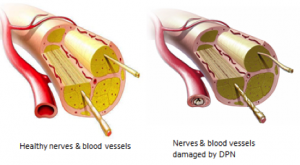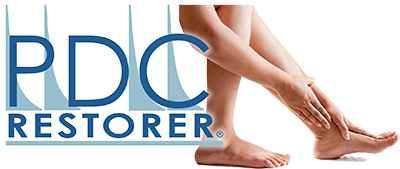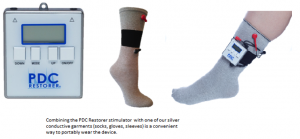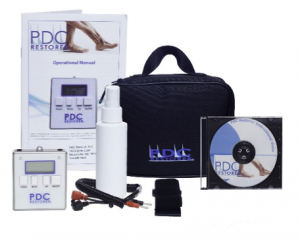Now there is a Non-Drug approach to treating symptoms of Diabetes Neuropathy and other Neuropathic Pain – Introducing the PDC Restorer™
Neuropathy
Neuropathy is a result of damage to the nerves of the peripheral nervous system, preventing communication between the central nervous system and all other parts of the body. These nerves affect virtually all of our bodily functions, such as the circulatory system, digestive system, reproductive system, osteo-skeleton system, and immune system. When these nerves malfunction, the signals to peripheral nerves are distorted. Nerve signaling in neuropathy is disrupted in three ways:
- loss of signals normally sent (like a broken wire)
- inappropriate signaling when there should not be any (like static on a telephone line)
- errors that distort the messages being sent (like a wavy television picture)
Approximately 20 million people in the United States have some form of neuropathic pain and related symptoms.¹
Causes of neuropathy include diabetes where high blood sugar damages the nerves, usually in the feet and hands. Other causes include Vitamin B12 deficiency, chemotherapy, poisonous toxins from exposure to pesticides and insecticides, trauma or injury to the body, and the effects of some cancer.
Lack of Oxygen
It is considered that 90% of all neuropathy is due to a lack of oxygen, the other 10% is caused by physical trauma. Neuropathy results when nerve signal propagation is reduced between adjacent nerve cells due to insufficient oxygen being available to support nerve cell metabolism. The lack of hypoxia can cause contraction of the nerve cell, loss of synaptic fluid between the nerve cells, and changes of electrical activity in cell membranes that cause a lack of sensitivity to signals and begin to damage the nerves.²
 Damaged nerves then can lead to sensory loss in the hands and feet; symptoms may be numbness, prickling or tingling sensation, and even sharp, burning pain. Left untreated, diabetic peripheral neuropathy can result in foot ulcerations or even amputations.
Damaged nerves then can lead to sensory loss in the hands and feet; symptoms may be numbness, prickling or tingling sensation, and even sharp, burning pain. Left untreated, diabetic peripheral neuropathy can result in foot ulcerations or even amputations.
What are some of the prescribed treatments for diabetic neuropathy?
Leading treatments for neuropathy include over-the-counter pain medications, a variety of topical cream treatments and even some anti-depressants. Drugs such as Gabapentin (Gralise, Neurontin), Pregabalin (Lyricia), and Carbamazepine (Carbatro, Tegretol, others), which were originally used to treat seizure disorders (epilepsy), are also prescribed for nerve pain. Side effects may include drowsiness, dizziness, and swelling. Physicians are sometimes concerned of prescribing these drugs due to the systemic effect of having the drugs absorbed throughout the body.
An Alternative to traditional Neuropathic Pain Treatment – The PDC Restorer™
Consider the PDC Restorer™ stimulator as a potential alternative to traditional treatment to neuropathic pain. The PDC Restorer™ is a small electrical stimulator that provides impulses through silver conductive garments that can increase blood flow and oxygenation³ in patients with neuropathy. Patients can wear the comfortable, stretchable silver conductive garments (sock, glove) on their extremities, which is far more effective than typical small 2” or 3” round self-adhesive electrodes and difficult to administer. Patients have the option to administer Program 1, which is a sixty minute treatment performed 2-3 times daily, or Program 2, which is a nighttime treatment which helps for patients with burning, prickling pain that sometimes occurs at night.
A Different Approach to Traditional TENS therapy
The PDC Restorer™ is listed by the FDA as a transcutaneous electrical neuromuscular stimulator or TENS, but it operates on a much different level than traditional TENS devices due to its pulsed direct current waveform. The vast majority of TENS devices sold on the market utilize an alternating current or AC biphasic current. AC biphasic current devices are effective in managing chronic pain such as back pain due to its ability to send a blast of strong electrical pulses from a stimulator which is attached to small self-adhesive electrodes. This blast of current causes a tingling sensation that typically overrides the pain signal going to the central nervous system. However, the application of this type of TENS treatment is usually ineffective when dealing with neuropathic pain dues to its inability to deal with nerves that are damaged and have insufficient oxygen going to them.
The PDC Restorer™ works at a micro-current level utilizing less voltage than traditional TENS devices. The DC micro-current travels in a one way loop that works on the molecular level to help the body heal itself. The body has its own bioelectric system, and this electrical activity at the cellular level (and the role it plays in wound healing) is now very well researched.² Damaged nerves typically have depleted oxygen flowing through them. The PDC Restorer’s direct current waveform has research showing its capability to increase oxygen and blood flow.³ These treatments help to restore blood circulation, sensation and the reduction of pain in patients.
Typically the PDC Restorer patient user will not feel the current during a treatment. Fortunately, the patient does not need to feel the current during a treatment in order to derive benefit from it. Traditional TENS users, however, have to feel the current from the treatment in order to override the pain message going to the central nervous system.
Another advantage of the PDC Restorer™ is the nocturnal or nighttime treatment which can be administered to help those patients suffering from the stabbing, burning pain symptoms that occurs primarily at night. In contrast, almost all TENS manufacturers suggest not wearing their TENS for nighttime use.
The graph below hopes to demonstrate the difference between the PDC Restorer™ versus Traditional TENS devices:
| Comparison of features | PDC Restorer™ | Traditional TENS |
| waveform | Twin peak DC | Alternating Current |
| Theory of operation | Cellular/molecular | Gate Theory |
| Treatment length | 2-3 daily, 60 minutes | 8-12 hours per day |
| Reduce Edema | Yes | No |
| Work effectively with conductive garments? | Yes | Typically not |
| Run treatments below sensation threshold? | Yes | No, users have to feel the stimulation |
| Nocturnal Protocol? | Yes | No |
| Treatments performed in water? | Yes | No |
Typical Treatment using the PDC Restorer™
Patients using the PDC Restorer will first spray the affected area with our conductive electrolyte spray that makes the treatment more comfortable as well as enhancing the conductivity of the stimulation. The patient then dons the silver conductive garment (sock, glove, knee, elbow, or amputee sleeve) and chooses either the hour long Program 1 treatment or the overnight Program 2 treatment. Once the intensity is set, the user then can place the PDC Restorer device on the elastic Fabrifoam® strap that can be placed around the calf or wrist for use.
Not feeling the current while the treatment is performed is normal. We recommend that the patient start with treatments using Program 1 the daytime treatment and eventually using Program 2 for nighttime use. Patients typically can feel a reduction of symptoms in their affected foot or hand usually after about 4-5 daily treatments.
Contraindications
Typically there are no unwanted side effects from the PDC Restorer™ treatment, but there are contraindications the user should be aware of before using this device. These include the following conditions:
- Pregnancy
- Wearers of cardiac pacemakers or defibrillators
- Patients with active case of cancer (due to PDC’s ability to increase blood flow)
- Undiagnosed pain symptoms, until etiology is determined.
So, begin breaking away from the unwanted side effects of medication and try the PDC Restorer™ as an alternative to treating neuropathic pain and symptoms.
Pictured below is everything available in the PDC Restorer™ kit. Garments are purchased separately. See “product/accessory” header for further information
The PDC Restorer™ Kit includes: PDC Restorer™ stimulator, lead wires, 4 oz. bottle of conductive spray, 2” wide Fabrifoam® strap, Quick Start Manual, DVD instructional video, 2 AAA batteries and manual.
References:
¹ National Institute of Health, August 16, 2018.
² Young, JD, US Endocrinology, 2005;(1): 46-50
³ Goldman, RJ, Brewley, BI, Golden, MA, ‘Electrotherapy re-oxygenates inframalleolar ischemic wounds on diabetic
patients: a case series’, Advance Skin Wound Care, May-June 2015: 112-20.



